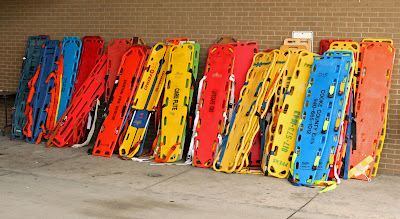Alameda County, known for Highland Trauma Center, is getting rid of long spine board immobilization.[1],[2]
Long spine board immobilization is continuing to be replaced by the lateral trauma position in Norway.[3],[4]
This year the NAEMSP (National Association of EMS Physicians®) considered passing a Position Statement that included the following wording –
- Securing a trauma patient to an EMS stretcher without a long backboard whether or not a cervical collar is being used is acceptable for maintaining spinal precaution during transport.[5]
Is there any good reason for that position statement to not be approved in the new year?
As of today, EMS at Yale-New Haven will no longer be using long boards for many of the patients they immobilize.
Effective immediately, long backboards will no longer be utilized for spinal immobilization of ambulatory patients. Patients who are ambulatory at the scene, but who require cervical spinal immobilization based on our selective spinal immobilization protocol, will be placed in an appropriately sized collar, seated on the ambulance stretcher, and secured in the position of comfort, limiting movement of the neck during the process. This change in procedure is the first step toward eventually using long boards only when needed to facilitate extrication, and not during transport.[6]
I applaud these systems and encourage them to continue this improvement in the care of their patients.
These boards belong in a museum of medical curiosities, not under patients with possible spinal injuries.

Picture credit from Voodoo Medicine Man.
The idea of using backboards for spinal immobilization should seem as perverse as the idea behind this method of suction.
–
Footnotes:
–
[1] Why We Need to Rethink C-Spine Immobilization
By Karl A. Sporer, MD, FACEP, FACP
Created: November 1, 2012
EMS World
Article
–
[2] Stop the Madness! Reducing Unnecessary Spinal Immobilizations in the Field – Part I
Thu, 08 Nov 2012
Rogue Medic
Article
–
[3] The lateral trauma position: what do we know about it and how do we use it? A cross-sectional survey of all Norwegian emergency medical services.
Fattah S, Ekås GR, Hyldmo PK, Wisborg T.
Scand J Trauma Resusc Emerg Med. 2011 Aug 4;19:45.
PMID: 21816059 [PubMed – in process]
Free Full Text from PubMed Central with links to PDF Download
–
[4] The Lateral Trauma Position: What do we know about it and how do we use it
Sun, 04 Dec 2011
Rogue Medic
Article
–
[5] EMS spinal precautions and the use of the long backboard
Proposed Position Statement
NAEMSP
Not available on NAEMSP web site, but forwarded by NAEMSP members interested in increasing awareness of the issue.
Position Statement
EMS spinal precautions and the use of the long backboard
The National Association of EMS Physicians believes that:
- There is no demonstrated outcome benefit of maintaining rigid spinal immobilization with a long backboard during EMS transport of a trauma patient.
- The long backboard can induce respiratory compromise, patient agitation and additional pain. Further, the backboard can decrease tissue perfusion at pressure points, leading to the development of pressure sores.
- A long backboard or similar device may be useful to facilitate spinal precautions during patient extrication.
- Patient time on long backboards should be minimized.
- Securing a trauma patient to an EMS stretcher without a long backboard whether or not a cervical collar is being used is acceptable for maintaining spinal precaution during transport.
- Implementation of protocols that deemphasize the use of the long backboard should involve all affected partners in the EMS system.
–
[6] YNHSHP Backboard Memo
Nov. 12, 2012
Yale-New Haven Sponsor Hospital Program
Not yet available on their web site.
.




[…] is low, but lately, this engine has gathered mighty steam. Rogue Medic in The Slow, Agonizing Death of Conventional Spinal Immobilization recently reported that members of the National Association of Emergency Medical Services Physicians […]